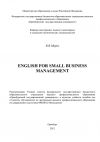Правообладателям!
Представленный фрагмент книги размещен по согласованию с распространителем легального контента ООО "ЛитРес" (не более 20% исходного текста). Если вы считаете, что размещение материала нарушает ваши или чьи-либо права, то сообщите нам об этом.Читателям!
Оплатили, но не знаете что делать дальше?
Текст бизнес-книги "Английский язык в экономике, бухучете и банковско-финансовой деятельности"
Автор книги: О. В. Иванов
Раздел: Жанр неизвестен
Возрастные ограничения: +12
Текущая страница: 1 (всего у книги 2 страниц)
Английский язык в экономике, бухучете и банковско-финансовой деятельности
В. И. Иванов
О. В. Иванов
© В. И. Иванов, 2018
© О. В. Иванов, 2018
ISBN 978-5-4493-9654-9
Создано в интеллектуальной издательской системе Ridero
От авторов
Данная работа представляет собой сборник текстов на английском языке, которые объединяет одна область знаний – экономика. Вошедшие в него материалы взяты в том числе из оригинальных англоязычных открытых интернет-источников, и их тематика связана с различными аспектами экономики США.
Для удобства тексты сгруппированы по следующим разделам: макроэкономика, бухгалтерский учет, инвестиции и банковское дело, коммерческие контракты. Это позволяет пользователям выбирать интересующую их тематику текстов.
Предлагаемый сборник текстов может служить пособием по совершенствованию английского языка. Для этой цели после некоторых текстов следуют авторские упражнения на закрепление предлагаемых материалов, а также перечень полезных слов и выражений, которые можно использовать в своей повседневной деятельности. Включенные в пособие упражнения, иллюстрации и глоссарии предназначены для лучшего понимания прочитанного, закрепления лексического материала и терминологии, а также для расширения словарного запаса учащихся с целью практического применения полученных знаний на практике.
Пособие предназначено для различных категорий лиц, изучающих английский язык, в том числе для студентов экономических ВУЗов всех специальностей, для студентов лингвистических ВУЗов, в частности переводческих факультетов, для специалистов-экономистов, а также для всех лиц, желающих совершенствовать свои знания английского языка в области экономики, особенно, если планируется применение этих знаний в работе за рубежом или в сотрудничестве с иностранными компаниями.
Отдельно хотелось бы выделить раздел B: Accounting, где часть текстов простым и доступным для любого читателя языком объясняют основные цели, понятия и инструменты бухучета, которые на первом этапе чрезвычайно сложны и непонятны людям, не связанным с практикой бухучёта или только начинающим его изучать.
В раздел D: Sales Contracts включены в том числе образцы действующих или исполненных контрактов белорусских предприятий со всеми приложениями. Почти всегда их перевод на английский язык выполняли сами белорусские предприятия. К сожалению, качество этих переводов оставляет желать лучшего. В данный сборник они включены в качестве примерного контракта. Желающие могут попытаться их откорректировать и использовать как шаблон применительно к специфике своих предприятий и организаций.
Составители данного сборника являются авторами только предложенных в разделе A: Macroeconomics упражнений. Авторы/источники текстов указаны в начале/конце текстов, в списке использованной литературы, а также в гиперссылках.
A: Macroeconomics
Text 1. International commerce: From the Civil War to the Present
In 1866 America was a net importer of merchandise, as it had been in most years before the Civil War. During the war, tariffs had risen, and the depreciation of the dollar had offered an added barrier to imports. On the other hand, America’s major export, raw cotton, had fallen off dramatically.
The tariffs imposed during the Civil War were retained, and throughout the late nineteenth and into the twentieth century (to 1913), the pattern was one of still higher duties. Behind a tariff wall, American industry flourished. Goods formerly imported were now made in America, and imports changed from manufactured goods to the raw materials needed to make them (such imports typically came in duty-free). Tariffs notwithstanding, total imports rose as the American population grew and demand increased.
In the aftermath of the Civil War, raw cotton resumed its traditional role as America’s largest export good (from 1803 to 1937, the Civil War and two other years excluded, unmanufactured cotton was America’s largest merchandise export). The country was also an important exporter of grain and mineral products. Yet, what most characterized the growth of American exports in the late nineteenth and early twentieth centuries was the rise of manufactured goods exports: refined petroleum, machinery, and other manufactured goods. Some exports were goods that had previously been imported, but usually they were mass-produced products made by methods not yet used abroad (such products included sewing machines, harvesters, and then, automobiles). Exports increased rapidly as American goods became highly competitive in world markets.
Indeed, as imports rose, exports rose even faster with the consequence that (at first sporadically and then consistently after 1889) exports always exceeded imports until 1971. When the balance of trade remained consistently positive, Americans gradually recognized that a high tariff policy was no longer necessary or even desirable. In 1913, with traditionally low-tariff Democrats in control of Congress, the Underwood Tariff lowered duties substantially. International commerce expanded faster in the late nineteenth and early twentieth centuries than did worldwide output, the gold standard aiding in the growth.
American exports soared in the aftermath of World War I, as Europe depended on the United States for aid in recovery. In 1919 U.S. exports reached a level that would not be exceeded until 1943. There was another change of importance. Most U.S. trade had been financed before the war with sterling acceptances (credits denominated in pounds sterling). During World War I, dollar acceptances came into use. This meant Americans were financing their own trade. A third change was that with Republicans in power in the 1920s, the notion of reduced protectionism floundered (in 1922, the Fordney-McCumber Tariff raised duties, especially to protect new «infant» industries such as chemicals). When, after the 1929 crash, Congress was trying to deal with the downturn, it was easy to blame imports, and the 1930 Smoot-Hawley Tariff was exceptionally high.
In the 1920s, country after country that had abandoned the gold standard during World War I had sought to restore it, but the restoration proved temporary. In 1929–1933 world output declined; countries devalued their currencies to encourage exports, yet world trade plummeted. The 1930 Smoot-Hawley Tariff provoked retaliation: it reduced American imports, but owing to new foreign duties on U.S. products, American exports fell faster. In the 1930s, new barriers to U.S. exports proliferated – not only foreign tariffs but exchange controls, quotas, and a whole range of other impediments to trade. Currencies fluctuated against one another, creating unpredictable conditions. In 1933 the United States devalued the dollar and in 1934 attempted to spur exports with reciprocal trade legislation. But by then the world economy was in such disarray that these efforts did little good. In the second half of 1940 the United States, in response to Japanese militarism, started to restrict U.S. exports to Japan and in August 1941 sharply curtailed the flow of crude oil and gasoline to that country. Many believe that these trade sanctions provoked the Japanese attack on Pearl Harbor.
World War II requirements revived international trade and, specifically, American exports. In the aftermath of that war, America emerged as the world’s economic leader, dedicated to developing a world of greater and freer trade. Its exports exceeded imports, because its goods were highly competitive in world markets. America was strong and physically unimpaired by the war; other industrial countries were in ruins. The United States was committed to lead and to shape a postwar world where trade could serve as a generator of economic growth. The United States was active in the formation of the International Monetary Fund, designed to provide a basis for the return to stable currency rates and to facilitate international payments; international trade could not resume if there were not adequate payment mechanisms. Likewise, the United States participated in the General Agreement on Tariffs and Trade (gatt), to assist countries in eliminating the then ubiquitous obstructions to international commerce. The Marshall Plan assisted both European recovery and American exports to Europe.
In 1962 Congress passed a major trade law, and the United States sharply lowered its tariffs. The United States as the world’s leader believed that it had little to fear from imports and everything to gain from demonstrating its dedication to freer trade. The nation continued to participate in gatt, and the Kennedy round of trade negotiations (completed in 1967) was particularly successful in encouraging worldwide tariff reductions.
Yet as trade barriers fell in the 1960s, America began to experience balance of payments deficits; goods exports still exceeded goods imports (the trade balance), but the net exports did not offset U.S. foreign aid, military expenditures abroad, and large foreign investments. In 1971, when it appeared that America would have its first twentieth-century trade deficit, President Nixon devalued the dollar. After 1973, worldwide currencies floated. Consistently, American imports began to exceed exports, and the country was now importing a wide range of manufactured products. For the first time in its history, on a mass market basis, Americans were buying foreign cars, foreign hi-fi sets, and foreign steel. And the nation’s dependence on high-cost oil imports made the trade deficit even worse. By the 1980s there were few product categories where American exports exceeded imports (these exports included wheat, chemicals, aircraft, and parts).
Most economists thought the fluctuating dollar would in time eliminate the trade deficit (as the American dollar fell, U.S. exports would become cheaper and thus more competitive; more costly imports would be reduced). The trade deficits, however, continued, and the dollar fluctuated wildly. Finally in the 1980s many economists recognized that floating exchange rates were not the answer, but attempts at currency stabilization proved difficult. Foreign markets for American agricultural products had been lost in periods of the strong dollar and were hard to recapture. As U.S. imports of manufactured goods increased, numerous discussions focused on America’s competitive position. Demands mounted for protectionism – to save jobs. The 1988 Omnibus Trade and Competitiveness Act allowed the president to impose sanctions on individual nations that engaged in unfair trade practices.
In the 1970s and 1980s, Americans groped for ways to become more competitive in the world economy and, in turn, to deal with the persistent excess of goods imports over exports. The continuing trade imbalance, particularly with Japan, spurred controversy. Was it the fault of Americans: low productivity increases, absence of goods desired abroad, lack of attention to exports? Was it that the dollar had not declined sufficiently to make U.S. goods attractive to foreign buyers? Or, was it that America’s trading partners acted in ways that were prejudicial to U.S. exports? Perhaps it was all of these. Clearly, however, American producers and consumers chose to buy imports, often preferring goods made abroad to those manufactured at home. The rise of imports relative to exports was critical to the trade deficit.
Mira Wilkins
EXERCISES
Exercise 1. Say if each of the following statements is true or not.
1. In the 19th century America was a net exporter of merchandise.
2. In the early 20th century America imported grain and mineral products.
3. U.S. exports increased after WWI and WWII.
Exercise 2. Answer the questions.
1. How did high tariffs and duties influence American economy in the late 19th century?
2. When did the U.S. exports reach the highest level?
3. How can you describe world economy in 1920s through 1930s?
4. How did WWII influence international trade?
5. In what way did the U.S. promote international trade?
6. How did the fall of trade barriers influence the U.S. economy?
Exercise 3
1. How do you understand the term «net importer»?
2. Are high tariffs and duties beneficial to a country’s economy?
3. Under what circumstances would you recommend to introduce trade barriers in your countries?
Exercise 4. Translate into English.
1. Главной статьей экспорта этой страны является хлопок-сырец. 2. Для защиты внутреннего рынка были введены высокие тарифы и таможенные пошлины. 3. Наиболее характерным для роста американского экспорта был рост экспорта промышленных товаров. 4. Экспорт всегда превышал импорт, и внешнеторговый баланс всегда оставался положительным. 5. Большинство экономистов полагало, что плавающий курс доллара со временем ликвидирует внешнеторговый дефицит. 6. Для экономики страны были характерны низкие темпы роста производительности, отсутствие товаров, пользующихся спросом за границей, и недостаточное внимание к экспорту.
Text 2. Government and the economy
In the relationship between government and the economy, ideas influence policies and policies shape outcomes. This three-way connection is sometimes direct, sometimes tenuous, sometimes perverse. Of the three elements, the easiest to evaluate historically is outcomes. By almost any measure, the American economy is the most successful the world has ever known. Even in colonial times the standard of living was generally better in America, at least for whites, than in Europe or Asia. In the decades following the American Revolution, economic growth remained high and remarkably steady. By the end of the nineteenth century, the United States surpassed all other countries in both agricultural and industrial output.
For most of the twentieth century, gross national product per capita has remained higher in the United States than in any other country, with the occasional exception of small advanced economies such as Switzerland and Denmark or oil-rich nations such as Kuwait. Only in the 1980s was the United States overtaken by countries such as West Germany and Japan, and even then only by the measurement of gnp per capita at exchange rates favorable to the deutsche mark and yen. By any other index of quality of life, the American standard of living was still the highest in the world.
If this outcome of unique affluence is clear, the ideas and policies behind it remain open to interpretation. How much did American economic success derive from laissez-faire ideas and policies, how much from governmental intervention? How much did it stem from neither of these but from the simple fact of a wealthy, isolated, and sparsely inhabited continent ready for exploitation? Assuming, for the sake of argument, that the early policies can be characterized as laissez-faire, then how much of the letting alone originated in the reasoning of Adam Smith and Thomas Jefferson, how much in the practical impossibility of effective public administration over a far-flung country?
In tracing the ideas behind American economic policies, the colonial period is the proper starting place. As the historian Carl Degler once remarked, «Capitalism came in the first ships.» The English settlers of North America brought with them clear convictions about the nature of sovereignty and the rights of property. These ideas, and the resulting policies, then interacted with the circumstances of a rich and underpopulated continent to set the context of economic activity.
During most of the colonial period, the hand of government lay lightly on the economy. This was true even allowing for such exceptions as the harshness of Puritan rule in early New England, the heavy taxation of Chesapeake tobacco by the English Crown, and the odious institution of slavery. When the colonists did revolt in 1775, it was in large measure against Britain’s new revenue policies of the 1760s and 1770s, which conveyed to American shores a fresh corps of administrative officials. This new regime brought taxation without representation, together with other violations of the «rights of Englishmen.»
The intellectual contours of the American Revolution suggest that the United States was born in a broad outburst of anti-authoritarianism that transcended any temporary disaffection from George III, the British monarch. This anti-authoritarianism is plainly reflected in the texts of contemporary documents: the scores of revolutionary pamphlets calling upon Americans to throw off the British yoke, the Declaration of Independence, the Constitution, the Federalist Papers, and the Bill of Rights. All of these late-eighteenth-century documents express the deep-seated aversion to absolute authority, the hostility to centralized power in which the Union was born. Even though the Constitution seemed to many revolutionaries to imply an unduly centralized government, it still vested ultimate sovereignty in «the people» and divided governmental power among three branches, each possessing the power to check the other two. In still another balancing act, the federal government as a whole both checked and was checked by state governments. As Charles Evans Hughes once remarked, the Founding Fathers had designed «the most successful contrivance the world has ever known for preventing things from being done.»
Given these institutional limitations on authority, can it be said that the government of the United States historically followed a policy of laissez-faire? Perhaps, but only as measured against Soviet-style command economies or the statist developmental policies of Napoleonic France, Bismarckian Germany, or Meiji Japan. Compared with liberal regimes such as that of Victorian Britain, the American government violated laissez-faire as often as it practiced it.
Broadly speaking, both federal and state governments were active in the economic sphere during the first half of the nineteenth century, passive in the second half, and then active again throughout the twentieth century. In the first half of the nineteenth century, state governments chartered numerous banks and expended public funds liberally for internal improvements such as canals, turnpikes, and railways. Meanwhile, the federal government promoted agricultural exports, protected domestic industry through tariffs, subsidized commerce through a generous postal rate structure, and encouraged the building of railways. Equally important, and often overlooked in analyses of government-business relations, the national government pursued an energetic and relentless policy of land acquisition and development. During the nineteenth century, more individual Americans made their fortunes from the exploitation of newly annexed lands than from any other source. «Manifest destiny» was an operative economic policy as well as a slogan of nationalism and empire, as the geographical extent of the United States was multiplied severalfold by the addition of the Old Northwest, the Louisiana Purchase, the Florida Cession, the Mexican Cession, the Gadsden Purchase, the Oregon Territory, and the acquisition of Texas, Alaska, and Hawaii.
In less visible ways, the legal order of the United States was shaped so as to lubricate the operations of private enterprise. Decade by decade, the states relaxed requirements for the privilege of incorporation, far in advance of parallel developments in Europe. In bankruptcy law, incentives were fashioned so as to favor debtors more than creditors, a reversal of common European practice. Similarly, contract law became highly refined in America, facilitating commerce among the disparate populations of strangers who came to American shores and pushed ever westward. Meanwhile, taxation remained light, a circumstance made possible by ample revenues from the sale of public lands and from customs duties on goods imported from Europe. All of this added up to a situation uncommonly hospitable to what the legal historian Willard Hurst has called «the release of energy.» Policymakers had systematically designed a fertile setting for private entrepreneurship – a greenhouse for business. So long as individual companies stayed small, no real conflict between the welfare of the American people and that of its business units became serious. Unfortunately, that happy situation endured only until the 1880s.
Big business (trusts) appeared in the United States during that decade, a good deal earlier than in most other countries. Once established, it grew faster and to a larger size than it did elsewhere. One reason was the absence of any countervailing force in America. A new country made up entirely of immigrants (except for the Native Americans), the United States had no established church, no standing army, no hereditary aristocracy, no mandarin class, no feudal tradition. Because of the nation’s individualistic ideology, almost no government ownership of business enterprise existed, in contrast to substantial public undertakings even in other market economies, let alone socialist ones. The exceptions to this rule became famous largely because they were exceptions: the Erie Canal in the nineteenth century, the Panama Canal Company and the Tennessee Valley Authority in the twentieth. Throughout American history, including the present time, the total tax bite of all governmental units has typically been less than in comparable industrial countries such as Britain, France, and Germany. Until the twentieth century, the absolute size of the national government remained minuscule, and even today it is relatively smaller than those of other countries. In 1871, at the dawn of the age of big business, the federal government employed only fifty-one thousand civilians, of whom thirty-seven thousand were postal workers. The remaining fourteen thousand constituted the entire national government of a country with a population of 41 million. This amounted to one federal worker per twenty-nine hundred inhabitants in contrast to about one per hundred in the late twentieth century.
Of all major market economies, the rise of big business preceded that of big government only in the United States. And when big business came, no countervailing force resisted its initial impact. Thus, the manifold problems it raised provoked a powerful public response that immediately moved into the realm of politics. In the closing years of the nineteenth century, the United States became the only major industrial power to enact legislation explicitly designed to curb the power of large corporations. Congress passed the Interstate Commerce Act in 1887, the Sherman Antitrust Act in 1890, and the Federal Trade Commission and Clayton acts in 1914. The United States was the only country to attempt such a thoroughgoing regulation of railroads as that embodied in the Hepburn Act of 1906, which gave new teeth to the Interstate Commerce Act of 1887. In other nations, railroads were either publicly owned or smaller than the gigantic American companies, several of which employed more than 100,000 persons. Although many other countries eventually adopted antimonopoly laws, the Sherman Antitrust Act remains the most stringent in the world.
American regulatory practice during the twentieth century was shaped by three outbursts of legislation: during the Progressive Era (1901–1914), the New Deal (1933–1938), and the later period of focused concern for safety, social justice, and environmental protection (1964–1971). Although several exceptions might be noted, this legislation and the agencies it created generally were designed to restrain the power of business. An appropriate symbol is the giant statuary outside the Federal Trade Commission building in Washington, which depicts powerful, unruly horses being held in check by the hand of a man. American agencies with direct authority over business practices, such as the Securities and Exchange Commission, remain far stronger than their foreign counterparts.
In the United States, then, regulatory behavior in the twentieth century was typically restrictive. In other countries it was more often promotional. In some ways this represents a reversal of nineteenth-century practice, when the United States was the most hospitable of all countries to the conduct of business enterprise. The more precise point is that during the twentieth century, the promotional activities of the American government differed in kind from those elsewhere. In other countries, such measures focused on industrial planning, sectoral growth, and targeted key industries. Seen most clearly in the post-World War II activities of Japan’s Ministry of International Trade and Industry, industrial planning had many counterparts elsewhere: in French indicative planning of the 1950s and 1960s, in the corporatist interlocks of German banks, labor unions, and large firms, even in the experiments under Labour governments in Britain. None of these practices, all of which fall under the general rubric of «industrial policy,» took firm root in America, with the sole exception of what pejoratively has been called «Pentagon capitalism.»
In America, nearly all promotional management of the macroeconomy was a post-New Deal phenomenon and was Keynesian in outlook. It looked not to individual firms, industries, or sectors but to aggregates of the major national income accounts: consumption, investment, and government spending. It operated primarily on the demand side through management of fiscal policy. Its general aim was to counteract violent swings of the business cycle such as those that brought severe depressions in the 1890s and 1930s. The ideas that motivated it were complex, involving such Keynesian arcana as equations designed to compute the «autonomous spending multiplier» as a tool for setting tax policy. At the height of its influence in the 1960s, some Keynesians spoke confidently of fine-tuning the entire national economy. Subsequent events, including the Vietnam War, the combined high inflation and high unemployment of the 1970s, and the soaring fiscal and trade deficits of the 1980s, brought an embarrassed silence on the subject of fine-tuning.
Yet the fact remained that in the decades after World War II, the American state explicitly accepted the principle of a mixed economy and with it governmental responsibility for national economic well-being. This became evident starting with the Employment Act of 1946, an avowedly Keynesian measure, and it continued through all postwar presidencies – even that of Ronald Reagan, who, though no Keynesian, oversaw the most drastic (and hazardous) changes in fiscal policy since World War II. This overt acceptance of responsibility for economic performance epitomized the revolution in thinking about the connections among ideas, policies, and outcomes in the relationship between government and the economy.
Thomas K. McCraw
EXERCISES
Exercise 1. Answer the following questions:
1. Why there was no serious conflict between the welfare of the American people and that of its business units until 1880s? 2. Was the percentage of federal workers in the U.S. in the 19th century different from that in the late 20th century?
Exercise 2. Translate into English.
1. Даже в 19 веке уровень жизни в США, в целом, был выше, чем в Европе или Азии, по крайней мере для белых. 2. В 20 веке такой показатель, как валовый национальный продукт на душу населения, почти всегда сохранялся выше, чем в любой другой стране; редкое исключение составляли лишь малые высокоразвитые государства такие, как Швейцария и Дания, а также богатые нефтью государства такие, как Кувейт. 3. По всем другим показателям уровня жизни США превосходили и Германию, и Швейцарию. 4. В заключительные годы 19 века США стали единственной крупнейшей промышленно развитой державой, принявшей законодательство, явно расчитанное на свертывание могущества крупных корпораций. 5. Ни одна из этих стратегий не укоренилась в США.
Exercise 3. Subjects for discussion:
1. Can the Government influence in any way a nation’s economy?
2. Is Government’s interference in the country’s economy good or bad for the economy?
Правообладателям!
Представленный фрагмент книги размещен по согласованию с распространителем легального контента ООО "ЛитРес" (не более 20% исходного текста). Если вы считаете, что размещение материала нарушает ваши или чьи-либо права, то сообщите нам об этом.Читателям!
Оплатили, но не знаете что делать дальше?






